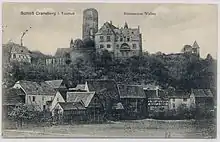
Camp Dustbin was a British-American interrogation camp located first at Chesnay, near Versailles, France and then moved to Kransberg Castle outside Frankfurt, Germany, during World War II. It served as a processing station and interrogation center for the German scientists, technicians, and administrators, captured during the war.[1][2]
Among them were leaders of V-2 missile project (including chief designer Wernher von Braun); leaders of the atomic and nerve-gas development projects; "members of the special research staff of the Reichsforschungsrat (Imperial Research Council)" (including its director, Werner Osenberg); members of German Ministry of Armaments and War Production (including the minister Albert Speer and his associates Karl-Otto Saur, Karl Maria Hettlage, Walter Dornberger and Theodor Hupfauer[3]); Abraham Esau, leading German expert on radar; directors of Telefunken; professor Friedrich Gladenbeck; industrialists like "steel barons Fritz Thyssen and Hermann Röchling, and Volkswagen’s Professor Ferdinand Porsche"; leading figures of I. G. Farben, developer of nerve gases: Gerhard Schrader, inventor of nerve gases tabun and sarin; Richard Kuhn, "inventor of the most toxic of the gases", soman;[1] and former Minister of Economics Hjalmar Schacht.[3][4]
The camp was open for the inmates, who "were free to wander around the castle grounds. The wrought-iron gates remained open. ... They passed the time by giving talks, listening to Schacht’s poetry and by staging a weekly cabaret mounted by the inmates that made light of their fate".[3][4]
In 1946, interrogations in camp Dustbin "had the aim of finding out about Soviet development projects as well as German wartime achievements"; "scientific workers threatened with kidnapping by agents of other countries, chiefly the USSR, were held there".[1]
Similar interrogation camp, Ashcan, was created in Luxembourg for the 86 most prominent surviving Nazi leaders prior to their trial in Nuremberg.
References
- 1 2 3 Maddrell, Paul (2006). Spying on Science: Western Intelligence in Divided Germany 1945-1961. Oxford University Press. p. 17-21. ISBN 978-0-19-170840-4.
- ↑ Crim, Brian E. (2021). "Allied Internment Camps in Occupied Germany: Extrajudicial Detention in the Name of Denazification, 1945–1950 by Andrew H. Beattie (review)". German Studies Review. 44 (3): 618–620. ISSN 2164-8646. Retrieved 28 December 2023.
- 1 2 3 Kitchen, Martin (24 November 2015). "12. Nuremberg". Speer. Yale University Press. p. 283. ISBN 978-0-300-21600-4. Retrieved 28 December 2023.
- 1 2 Andrew, Christopher; Tobia, Simona (29 April 2014). Interrogation in War and Conflict: A Comparative and Interdisciplinary Analysis. Routledge. pp. 96–97. ISBN 978-1-134-70338-8.